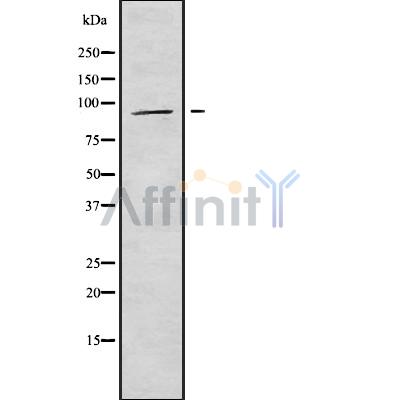APBA1 Antibody - #DF9202
| Product: | APBA1 Antibody |
| Catalog: | DF9202 |
| Description: | Rabbit polyclonal antibody to APBA1 |
| Application: | WB IF/ICC |
| Reactivity: | Human, Mouse, Rat |
| Prediction: | Bovine, Sheep, Rabbit, Dog |
| Mol.Wt.: | 93kDa; 93kD(Calculated). |
| Uniprot: | Q02410 |
| RRID: | AB_2842398 |
Product Info
*The optimal dilutions should be determined by the end user. For optimal experimental results, antibody reuse is not recommended.
*Tips:
WB: For western blot detection of denatured protein samples. IHC: For immunohistochemical detection of paraffin sections (IHC-p) or frozen sections (IHC-f) of tissue samples. IF/ICC: For immunofluorescence detection of cell samples. ELISA(peptide): For ELISA detection of antigenic peptide.
Cite Format: Affinity Biosciences Cat# DF9202, RRID:AB_2842398.
Fold/Unfold
Adapter protein X11 alpha; Adapter protein X11alpha; Amyloid beta A4 precursor protein-binding family A member 1; Apba1; APBA1_HUMAN; Mint 1; Mint-1; Neuron specific X11 protein; Neuron-specific X11 protein; Neuronal Munc18 1 interacting protein 1; Neuronal Munc18-1-interacting protein 1; UROP11; x11; X11alpha;
Immunogens
A synthesized peptide derived from human APBA1, corresponding to a region within N-terminal amino acids.
Brain and spinal cord. Isoform 2 is expressed in testis and brain, but not detected in lung, liver or spleen.
- Q02410 APBA1_HUMAN:
- Protein BLAST With
- NCBI/
- ExPASy/
- Uniprot
MNHLEGSAEVEVTDEAAGGEVNESVEADLEHPEVEEEQQQPPQQQHYVGRHQRGRALEDLRAQLGQEEEERGECLARSASTESGFHNHTDTAEGDVIAAARDGYDAERAQDPEDESAYAVQYRPEAEEYTEQAEAEHAEATHRRALPNHLHFHSLEHEEAMNAAYSGYVYTHRLFHRGEDEPYSEPYADYGGLQEHVYEEIGDAPELDARDGLRLYEQERDEAAAYRQEALGARLHHYDERSDGESDSPEKEAEFAPYPRMDSYEQEEDIDQIVAEVKQSMSSQSLDKAAEDMPEAEQDLERPPTPAGGRPDSPGLQAPAGQQRAVGPAGGGEAGQRYSKEKRDAISLAIKDIKEAIEEVKTRTIRSPYTPDEPKEPIWVMRQDISPTRDCDDQRPMDGDSPSPGSSSPLGAESSSTSLHPSDPVEASTNKESRKSLASFPTYVEVPGPCDPEDLIDGIIFAANYLGSTQLLSDKTPSKNVRMMQAQEAVSRIKMAQKLAKSRKKAPEGESQPMTEVDLFISTQRIKVLNADTQETMMDHPLRTISYIADIGNIVVLMARRRMPRSNSQENVEASHPSQDGKRQYKMICHVFESEDAQLIAQSIGQAFSVAYQEFLRANGINPEDLSQKEYSDLLNTQDMYNDDLIHFSKSENCKDVFIEKQKGEILGVVIVESGWGSILPTVIIANMMHGGPAEKSGKLNIGDQIMSINGTSLVGLPLSTCQSIIKGLKNQSRVKLNIVRCPPVTTVLIRRPDLRYQLGFSVQNGIICSLMRGGIAERGGVRVGHRIIEINGQSVVATPHEKIVHILSNAVGEIHMKTMPAAMYRLLTAQEQPVYI
Predictions
Score>80(red) has high confidence and is suggested to be used for WB detection. *The prediction model is mainly based on the alignment of immunogen sequences, the results are for reference only, not as the basis of quality assurance.
High(score>80) Medium(80>score>50) Low(score<50) No confidence
Research Backgrounds
Putative function in synaptic vesicle exocytosis by binding to Munc18-1, an essential component of the synaptic vesicle exocytotic machinery. May modulate processing of the amyloid-beta precursor protein (APP) and hence formation of APP-beta.
Cytoplasm. Cytoplasm>Perinuclear region. Nucleus.
Note: Only about 5% of the protein is located in the nucleus.
Golgi apparatus.
Brain and spinal cord. Isoform 2 is expressed in testis and brain, but not detected in lung, liver or spleen.
Composed of an N-terminal domain that binds Munc18-1 and LIN-2/CASK, a middle phosphotyrosine-binding domain (PID/PTB) that mediates binding with the cytoplasmic domain of the amyloid-beta precursor protein, and two C-terminal PDZ domains thought to attach proteins to the plasma membrane.
The autoinhibitory helix linker occludes the APP binding site.
The PID domain, truncated by 11 amino acids, as observed in isoform 2, but not full-length, mediates the interaction with RAB6A and RAB6B.
Restrictive clause
Affinity Biosciences tests all products strictly. Citations are provided as a resource for additional applications that have not been validated by Affinity Biosciences. Please choose the appropriate format for each application and consult Materials and Methods sections for additional details about the use of any product in these publications.
For Research Use Only.
Not for use in diagnostic or therapeutic procedures. Not for resale. Not for distribution without written consent. Affinity Biosciences will not be held responsible for patent infringement or other violations that may occur with the use of our products. Affinity Biosciences, Affinity Biosciences Logo and all other trademarks are the property of Affinity Biosciences LTD.

